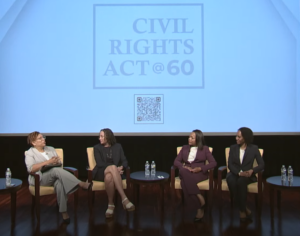While under hiring freeze, EEOC facing ‘very big task,’ Burrows says
For employees at the Equal Employment Opportunity Commission, workloads right now are much higher than they should be, EEOC Chairwoman Charlotte Burrows said.
Ever since the Equal Employment Opportunity Commission (EEOC) started investigating workplace discrimination cases back in 1965, the work has been practically non-stop.
At the same time, for current EEOC Chairwoman Charlotte Burrows, the ongoing challenge of balancing agency staffing levels with the number of incoming cases hasn’t gone away.

“We opened our doors a year to the day of the [1964] Civil Rights Act’s passage,” Burrows said in an interview with Federal News Network at a June 25 event recognizing 60 years of the landmark legislation. “On that day, we had about 100 employees, and we instantly were underwater with the number of charges. We had thousands of charges even on day one. It has been a problem that we have been wrestling with from the beginning.”
Over the years, EEOC’s workforce numbers have in turn both risen and declined, but for employees right now, workloads are much higher than they should be, Burrows said. It’s especially challenging given that the agency is operating under a hiring freeze for fiscal 2024.
“It’s very difficult,” Burrows said. “When someone leaves retirement or for whatever reason, we’re not able to replace them right now. So, by definition, we’re constantly having to figure out how to manage that and to be fair to our own workforce.”
Before the hiring freeze began, EEOC made 500 new hires during fiscal 2023, resulting in a 2,331-employee workforce at the end of the year, the agency said in its annual performance report. By comparison, that’s about 1,000 positions below 1980s staffing levels for EEOC, when the agency had roughly 3,300 employees. The now relatively smaller workforce, Burrows said, is coupled with a gradually growing workload.
“[Investigators are] carrying 100-plus cases each, in addition to having to do a regular rotation of taking in new matters,” Burrows said. “The average is about 100 per investigator, but we have some districts where we are way north of that. That is a real challenge and something that I personally worry a lot about.”
Between fiscal 2021 and 2022, EEOC’s charge backlog rose from 42,811 to 51,399 pending charges. During 2023, though, EEOC’s inventory held relatively steady with 51,100 charges, according to the most recent data available.
But also in 2023, EEOC secured more than $665 million in monetary relief for more than 22,000 victims of employment discrimination, the agency said. That includes securing more than $202 million in monetary relief for federal employees. Additionally, EEOC filed 143 workplace discrimination lawsuits for employees, an increase of more than 50% since the previous year.
As EEOC employees work through those discrimination charges, Burrows said it involves a lot of creativity to manage within limited resources.
“We do a lot with what we have, I don’t want to make any bones about that. But it is a very big task,” Burrows said. “We work strategically, we work smart, as well as hard, but [the workforce] is not right-sized, if you will, for the task at hand.”
Training is one way that EEOC tries to support employees, helping to develop their skills at the same time that they’re managing high workloads coming in. Burrows said EEOC has “doubled down” on training over the last couple years. In fiscal 2023, the EEOC approved $3.7 million in training programs for employees, the agency said.
“We had training funds, but we also did a lot to train internally,” Burrows said. “It also helps to build that sort of camaraderie and that teamwork mindset that’s so important to our success … We don’t have budget for a great deal of external training. But we are continuing to be creative and interested in looking at how to make sure that our people are trained.”
The nature of EEOC’s work has also changed significantly over time. Throughout the COVID-19 pandemic and now in hybrid work arrangements, discrimination has remained prevalent in the workplace, although appearing in different forms.
“The onset of more online workplaces will mean that we will continue to have to be nimble enough to follow the technology where it goes, so that we can make sure that we are protecting,” Burrows said. “I anticipate that one of the things that employees will have to continue to be vigilant about is the different ways that new technologies may make it easier for folks to reach into the private places of individual employees and to guard against ways in which that can become harassing or abusive.”
Aside from investigating cases, EEOC’s efforts also involve more proactive work such as outreach, education and technical assistance. Often, that can help agencies and other employers get ahead of discrimination cases — and in theory, reduce charges that come into EEOC’s hands.
“We have to be nimble enough now to bring those 1964 principles into the high-tech world that we are living in with respect to employment today,” Burrows said during a panel at Tuesday’s Civil Rights Act commemoration event. “If the discrimination happens, you can get a remedy. But it’s really important to try and get in front of it … A lot of employers have begun looking at how to do that — how to have more inclusive employment practices.”
Copyright © 2024 Federal News Network. All rights reserved. This website is not intended for users located within the European Economic Area.
Drew Friedman is a workforce, pay and benefits reporter for Federal News Network.
Follow @dfriedmanWFED






